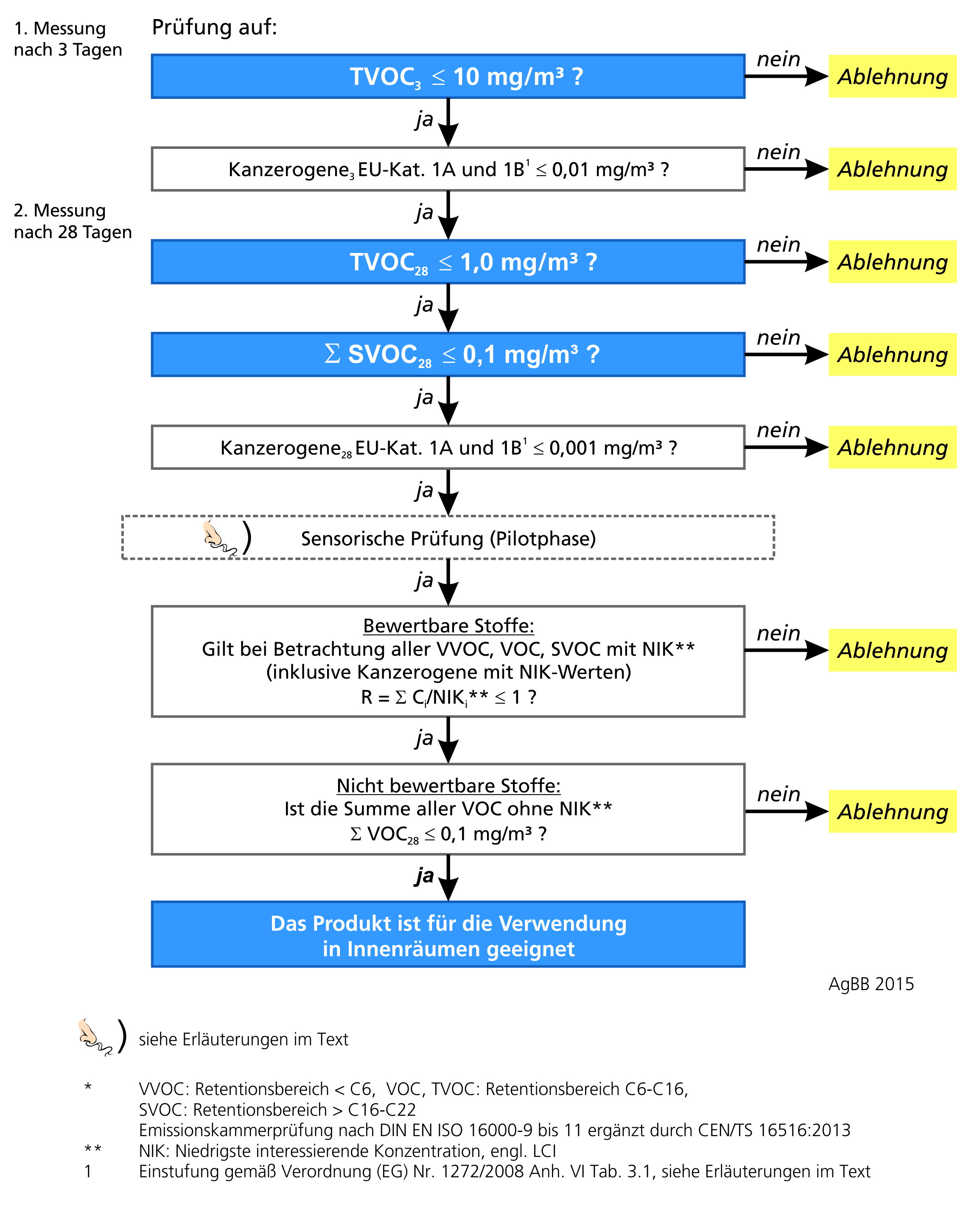The AgBB scheme (AgBB = Committee for Health-related Evaluation of Building Product Emissions) describes the procedure for the health-related evaluation of building product emissions. The scheme is based on a European research report (ECA Report No. 18). It has been used in Germany since 2002 for various voluntary emission labels and for general building inspectorate approvals by the German Institute for Building Technology (DIBt).
The AgBB scheme (Germany)

Building products are tested over a period of 28 days using an emission test chamber in accordance with DIN EN 16516. After three and after 28 days, air samples are taken from the test chamber atmosphere and analyzed. To successfully pass a test according to the AgBB scheme, a total of seven different emission criteria must be met:
- Assessment after 3 days: TVOC, K-substances
- Assessment after 28 days: TVOC, ΣSVOC, LCI substances, non-LCI substances, K substances
VVOC, VOC and SVOC emissions are analyzed as defined in the DIN EN 16516 test standard for the analysis of building product emissions. VOCs (volatile organic compounds) are volatile compounds that lie between hexane (C6) and hexadecane (C16) in the gas chromatographic analysis. VVOCs (very volatile organic compounds) are very volatile substances that elute before hexane (C6) in a gas chromatographic analysis. Formaldehyde, for example, is also a VVOC. SVOCs (semi-volatile organic compounds) are the less volatile emissions that lie between C16 and docosane (C22) in the analysis. The individual substances from the VOC and SVOC groups are summarized and evaluated as TVOC (total volatile organic compounds) and ΣSVOC (sum of semi-volatile organic compounds). A low TVOC value should not be achieved at the expense of low volatile emissions by limiting SVOC emissions. Very volatile substances from the VVOC group are included in the assessment as individual substances.
In the case of VOCs and SVOCs, however, not only total values are considered, but individual substances are also assessed. Individual substances are assessed using so-called LCI values, which are derived on the basis of toxicologically available data, such as occupational health and safety limit values, taking into account safety factors (factor 100-1000). Substances for which LCI values are not available due to a lack of toxicological data are classified as non-LCI substances, and their permissible sum is also limited. This is intended to prevent the occurrence of product emissions for which no toxicological information is available. For carcinogens, mutagens or reprotoxic substances (CMR), which are classified as category 1A or 1B in the EU (Regulation (EC) No 1272/2008), very strict limit values apply: After 28 days, these compounds must be virtually undetectable in the test chamber atmosphere.
Sensory testing
In addition to the evaluation of emissions measured by chemical analysis, the AgBB scheme also provides for sensory testing. The measurements are carried out on the basis of DIN ISO 16000-28, whereby the emissions of a building product are assessed in terms of odor by a large number of trained testers as part of a test chamber measurement. The so-called perceived odor intensity is determined.
Literature
- AgBB (Ausschuss zur gesundheitlichen Bewertung von Bauprodukten), 2021. Anforderungen an die Innenraumluftqualität in Gebäuden: Gesundheitliche Bewertung der Emissionen von flüchtigen organischen Verbindungen (VVOC, VOC und SVOC) aus Bauprodukten. Stand Juni 2021.
- DIN EN 16516:2020-10. Bauprodukte: Bewertung der Freisetzung von gefährlichen Stoffen - Bestimmung von Emissionen in die Innenraumluft. Beuth-Verlag, Berlin.
- ISO 16000-28:2020-11. Innenraumluftverunreinigungen - Teil 28: Bestimmung der Geruchsstoffemissionen aus Bauprodukten mit einer Emissionsprüfkammer. Beuth-Verlag, Berlin
- ECA - European Collaborative Action, lndoor Air Quality & lts Impact on Man, Report 18, Evaluation of VOC Emissions from Building Products. 1997.
